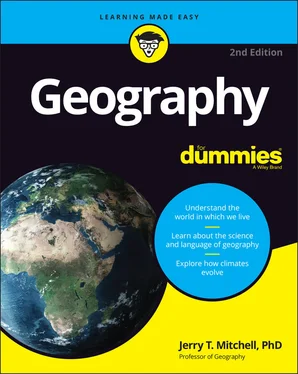Jerry T. Mitchell - Geography For Dummies
Здесь есть возможность читать онлайн «Jerry T. Mitchell - Geography For Dummies» — ознакомительный отрывок электронной книги совершенно бесплатно, а после прочтения отрывка купить полную версию. В некоторых случаях можно слушать аудио, скачать через торрент в формате fb2 и присутствует краткое содержание. Жанр: unrecognised, на английском языке. Описание произведения, (предисловие) а так же отзывы посетителей доступны на портале библиотеки ЛибКат.
- Название:Geography For Dummies
- Автор:
- Жанр:
- Год:неизвестен
- ISBN:нет данных
- Рейтинг книги:5 / 5. Голосов: 1
-
Избранное:Добавить в избранное
- Отзывы:
-
Ваша оценка:
- 100
- 1
- 2
- 3
- 4
- 5
Geography For Dummies: краткое содержание, описание и аннотация
Предлагаем к чтению аннотацию, описание, краткое содержание или предисловие (зависит от того, что написал сам автор книги «Geography For Dummies»). Если вы не нашли необходимую информацию о книге — напишите в комментариях, мы постараемся отыскать её.
Geography For Dummies
Geography For Dummies
Geography For Dummies — читать онлайн ознакомительный отрывок
Ниже представлен текст книги, разбитый по страницам. Система сохранения места последней прочитанной страницы, позволяет с удобством читать онлайн бесплатно книгу «Geography For Dummies», без необходимости каждый раз заново искать на чём Вы остановились. Поставьте закладку, и сможете в любой момент перейти на страницу, на которой закончили чтение.
Интервал:
Закладка:
 To sum up, I asked two questions: “What is the capital of Indonesia?” and “Why is Jakarta the capital of Indonesia?” Nothing is wrong with either question. But I trust you agree that the second is the more profound of the two. It calls for a deeper, more analytical brand of thinking and it leaves you with a more penetrating perspective on the geography of Indonesia and the significance of a number of factors. It can also lead us to other questions such as “What would it take for Indonesia to consider moving its capital? And if it did, what geographic conditions would be necessary in deciding on a new location?” Chapter 2expands on how to “think” geographically.
To sum up, I asked two questions: “What is the capital of Indonesia?” and “Why is Jakarta the capital of Indonesia?” Nothing is wrong with either question. But I trust you agree that the second is the more profound of the two. It calls for a deeper, more analytical brand of thinking and it leaves you with a more penetrating perspective on the geography of Indonesia and the significance of a number of factors. It can also lead us to other questions such as “What would it take for Indonesia to consider moving its capital? And if it did, what geographic conditions would be necessary in deciding on a new location?” Chapter 2expands on how to “think” geographically.
Getting to the Essentials
To get you accustomed to thinking geographically, this volume makes use of unifying concepts that will help you to understand the breadth and structure of the discipline. But what are these unifying concepts? Yogi Berra once supposedly ordered a pizza pie and was asked if he wanted it cut into four slices or eight. He opted for four and explained, “I don’t think I can eat eight.” Whether or not the story is true, a pizza pie is a pizza pie, no matter how you slice it up. The same is true of geography. In a manner of speaking, it’s a very big pizza pie. Over the years, geographers have devised different ways to cut it up in order to help people like you grasp its breadth and content. If you are a school teacher, you may have heard of the Five Themes of Geography or maybe even the Four Traditions. As I said, there have been many attempts to do this!
The “geography pizza slices” I’m going to introduce you to are The Six Essential Elements. They were developed by several professional geography organizations as part of the (United States) National Geography Standards, which describe in detail “what a geographically informed person knows and understands.” The National Geography Standards were written with the advice and input of professionals who specialize in diverse aspects of geography and, accordingly, represent a broad consensus of its scope and structure. Specifically, therefore, I have chosen The Six Essential Elements, which are:
The world in spatial terms
Places and regions
Physical systems
Human systems
Environment and society
Uses of geography
These may sound somewhat imposing, but rest assured, they refer to simple concepts that you encounter in your everyday life. Indeed, you are already familiar with each of them, though perhaps not by their formal titles. I can prove it to you.
Where things are in the world: The world in spatial terms
You probably have a preferred grocery store, clothing store, and restaurant, plus a map in your head that tells you where they are and how to get to them. What’s more, you could probably conjure up a route to visit all three in a single excursion and draw me a sketch map of the itinerary. If so, then you are already familiar with the world in spatial terms.
 Spatial refers to the location and distribution of things and how they interrelate. Accordingly, the world in spatial terms responds to geography’s most fundamental question: Where? Getting a handle on this element involves:
Spatial refers to the location and distribution of things and how they interrelate. Accordingly, the world in spatial terms responds to geography’s most fundamental question: Where? Getting a handle on this element involves:
Knowing how to use and read maps and atlases, whether paper or digital, and identify how they can lie to you (yes, you read that correctly).
Acquiring a general understanding of the tools and techniques that geographers use to accurately locate things.
Being able to indicate the location of something using the system of latitude and longitude, or plain language.
Seeing relationships that explain the locations of things.
Recalling from memory the location of things on Earth’s surface.
These are basic skills to build on. On top of that, you’ll never have to worry if somebody tells you to “Get lost!”
Chapter 2, which shows you how to think like a geographer, is very much about understanding the world in spatial terms. Chapters 3, 4, and 5are devoted to location and maps, and, therefore, focus rather directly on this element. In addition, several other chapters will contain at least one map. Thus, you will encounter the world in spatial terms again and again throughout this book.
What locations are like: Places and regions
What’ll it be for your next vacation? The mountains? The shore? Chances are you have mulled over questions like these that concern different areas with different characteristics. If so, then you are already familiar with places and regions.
Place: What a location looks like
Place responds to another important geographical question: “What is it like?” Place refers to the human and physical features that characterize different parts of Earth and that are responsible for making one location look different from the next. The terminology may puzzle you, because in everyday speech, people commonly use location and place interchangeably. In geography, however, these two terms have separate and distinct meanings. Location tells you where. Place tells you what it’s like . In other words, places are locations to which humans have assigned meaning.
Take, for example, the proliferation of streets in the United States named after Martin Luther King, Jr. Are they locations? Sure, they are. They have specific addresses along them and they occupy space in hundreds of cities. But I think that we can also agree that they are imbued with much meaning and create unique places. Further, where they are located also says a lot about the people, history, politics, and so on in the neighborhoods where we find them.
Region: A bunch of locations with something in common
A region is an area of Earth, large or small, that has one or more things in common. So when you say “I’m going to the mountains” or “I’m heading for the shore,” you refer to an area — a region — that has a certain set of characteristics over a broad area.
Regions make it easier to comprehend our Earthly home. After all, Earth consists of gazillions of locations, each of which has its own particular and peculiar characteristics. Knowing every last one of them would be impossible. But we can simplify the challenge by grouping together contiguous locations that have one or more things in common — Gobi Desert, Islamic realm, tropical rainforest, Chinatown, the Great Lakes, suburbia — each of these is a region. Some are big and some are small. Some refer to physical characteristics. Some refer to human characteristics. Some do both. But each facilitates the task of understanding the world.
 Lest you think that this categorization idea is unique to geography, consider history or geology. History uses eras to group together like periods of time. Geology uses the term epochs . Each of these also has unique geographic characteristics. If I use the historic era The Renaissance as an example, your mind races not only to a specific time, but probably also a place: Italy.
Lest you think that this categorization idea is unique to geography, consider history or geology. History uses eras to group together like periods of time. Geology uses the term epochs . Each of these also has unique geographic characteristics. If I use the historic era The Renaissance as an example, your mind races not only to a specific time, but probably also a place: Italy.
Features that characterize different locations on Earth and, therefore, epitomize the concept of place, will be the focus of several chapters. These include landforms ( Chapters 6and 7), climates ( Chapter 10), population ( Chapter 11), culture ( Chapter 13), economic activity ( Chapter 15), and urbanization ( Chapter 17). Each of these characteristics, of course, pertains not only to particular locations, but also to large areas as well. Thus, they also serve to characterize and define regions.
Читать дальшеИнтервал:
Закладка:
Похожие книги на «Geography For Dummies»
Представляем Вашему вниманию похожие книги на «Geography For Dummies» списком для выбора. Мы отобрали схожую по названию и смыслу литературу в надежде предоставить читателям больше вариантов отыскать новые, интересные, ещё непрочитанные произведения.
Обсуждение, отзывы о книге «Geography For Dummies» и просто собственные мнения читателей. Оставьте ваши комментарии, напишите, что Вы думаете о произведении, его смысле или главных героях. Укажите что конкретно понравилось, а что нет, и почему Вы так считаете.












